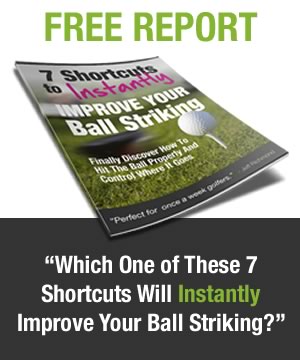The Long Game Improvement Plan – Part 5
In this part of the long game improvement plan we’re going to be discussing tempo, rhythm, timing and an automatic golf swing. So let’s start by looking at…
Rhythm & Timing
If you watch any great golfer’s swing they will have great rhythm and timing. But “trying” to swing with great rhythm and timing is wrong. You shouldn’t “try” to force these things to happen in your swing because trying causes tension.
Important Note: Unnecessary tension in the golf swing destroys timing, and rhythm.
Instead, I think it’s better if you simply observe great golfers swings over and over again to get a sense of the rhythm and timing needed in the golf swing.
To do this you can record swings of your favorite golfer that have great rhythm and timing, e.g.
- Ernie Els,
- Davis Love III,
- Fred Couples etc.
…and watch them swing over and over again. But I must say, that’s a good starting point but I’ve found a much better option than that which I share with my students. OK, let’s now look at…
Tempo
When I started looking into the tempo of the golf swing and how to practice it I found that professional golfers swing a lot faster than most people think. But the reason their swings look so rhythmical, smooth and slow is because everything in their swings flows smoothly. There’s no jerking movements, and that smoothness gives the entire swing an appearance of being smooth and slow.
Anyway, to improve my tempo I first tried swinging to a metronome but I found this very, very difficult. You just don’t have enough time to react to the beeps. So after trying that I read the book Tour Tempo…

….and I started using the audio tracks supplied with that book to swing to the tempos suggested. From using this audio CD myself to practice with, this is what I’ve found.
The faster the tempo I used the shorter my swing became. I think my natural tempo is 24/8 but when I practiced with that tempo I found my swing was too short. So I’ve now gone up to using 27/9 tempo and this is working well for now.
So if you get this book, and I highly recommend you do, I think you should work slowly into these tempos by starting at 27/9 and then trying the other quicker tempos after that tempo is comfortable. That’s just a suggestion however.
BUT no matter what you do, you’ll probably find that the tempos on that CD are a lot faster than you’re used to. So when you get this book just experiment with the different tempos.
Now the best thing about the audio CD that comes with the Tour Tempo book is that the tones or words are spaced so you have time to react to them. As I said, I’ve tried swinging to a metronome and that’s really tough. You simply don’t have the time to react to the beeps and change directions from the backswing to the downswing.
All right, let’s now look at…
Swinging The Club Automatically
Now there are two ways to mentally swing a golf club…
- Consciously, or
- Subconsciously
When you swing a golf club consciously you have a lot of thoughts going through your mind about what you should be doing mechanically, along with thoughts about the possible outcome of the shot. But when you swing subconsciously you don’t have any thoughts going through your mind about mechanics or the possible outcome of the shot.
This means you just swing automatically to the best of your ability, and generally when you’re doing this you hit good shots and you play your best golf. So obviously swinging subconsciously is the best way to swing a golf club. To do this consistently you need to learn how to do the following two things..
- Switch off your conscious mind just before you start your swing, leaving your subconscious mind free to swing the golf club to the best of your ability.
- Program your subconscious mind with the perfect golf swing for you.
To help you start doing this consistently, I give two audio tracks to my students to listen to.
But listening to those audios is only the start, because you’ve undoubtedly wasted many, many shots because of your conscious mind interfering in your shots (i.e. telling you how to swing the club or what to avoid etc.). You can only stop this from happening by learning to swing with your subconscious mind consistently.
How are you going to do this?
Well, when playing any golf shot you need to have a technique to distract your conscious mind and allow your subconscious mind free reign to perform the swing that you have programmed yourself with. Because without a technique to distract your conscious mind it is always in a constant state of flux. And to demonstrate how hard it is “try” to quieten your mind, do this.
Right now see how long you can hold the one thought of a pink elephant in your mind before another thought comes along.
Not long is it?
And it will never be long even if you practice this forever, because of the fact that your conscious mind’s purpose is to analyze, question and doubt. So unless you learn how to consistently swing with your subconscious mind your golf game will never be consistent and you’ll always play well below your potential, because the times when you’ve hit your best ever shots and played your best ever rounds is the result of you automatically swinging with your subconscious mind. No doubt you’ve heard about top golfers saying they’ve been in the “zone” and you’ve been there as well. The “zone” is simply when a person switches off their conscious mind and executes whatever skill they’re performing using their subconscious mind.
But as you’ve already proven to yourself, if you “try” to consciously quieten your conscious mind, you’ll end up fighting with your mind and you’ll get worse instead of better.
Now golfers that play nowhere near their potential almost always play with their conscious mind, which means the subconscious is not free to swing the golf club. And this means most golfers consistently play well below the potential they’re capable of. You can quite easily tell after every shot you hit whether you’ve used your subconscious or conscious mind to hit the ball.
How?
Simply by being aware of any tension in your body after the shot. If you have any major tension like you’ve been consciously controlling the shot then you’ve used your conscious mind to play the shot. And here’s another great way for you to see for yourself the difference between the subconscious and the conscious mind.
Get a pen and in the left-hand box below I want you to sign your name and as you do notice the way the pen flows over the paper.
Then I want you to try to consciously copy the signature exactly as you’ve just done it, this time in the right box….

Did you notice the big difference between the two movements?
See, trying to consciously copy your subconscious signature you would’ve noticed how slow, forced, and unnatural your hand moved as opposed to the free flowing actions of the first signature. This is because your conscious mind produces tension when trying to copy anything. So your perfect golf shots are clearly produced by your subconscious mind.
But when you consciously try to copy what you did to hit that perfect shot you naturally get the same forced, unnatural result that you received when you tried to consciously copy your signature. Clearly the only way to copy what you did to hit your perfect golf shots is to reproduce that mindset.
The only way to consistently do that is through using your subconscious mind to automatically swing the golf club. And the best way of doing that consistently is by using the tools I give you when you become a student of mine.
All right, that’s the end of Part 5 of this Report. I hope you enjoyed it.

